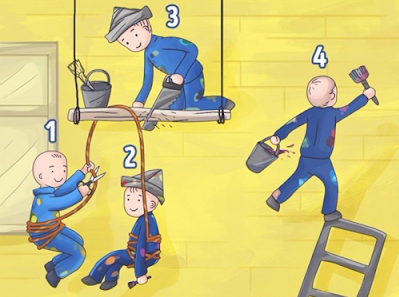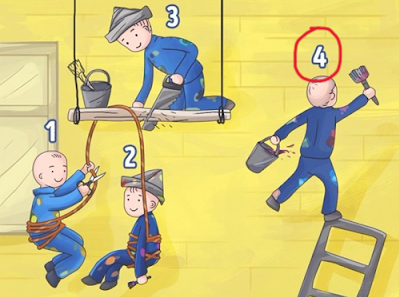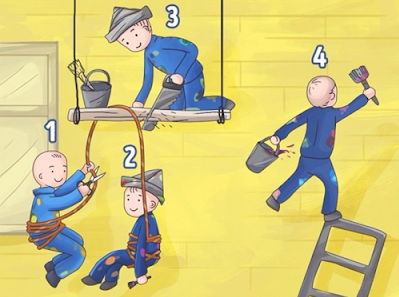Life is full of small challenges that push us to think critically, and this puzzle is no exception. Imagine this scenario: four painters are working on a yellow wall, each in a precarious position. The question seems simple: Who will fall first? However, as you dig deeper, you’ll realize this is a true test of observation, logic, and problem-solving skills.
Let’s break it down step by step, avoid common pitfalls, and solve this riddle together.
The Puzzle: A Quick Overview

Here’s the setup:
- Painter #1 is holding a rope attached to the wooden plank on which Painter #2 is sitting.
- Painter #2 is seated on the plank, appearing stable but entirely dependent on the rope’s support.
- Painter #3 is actively sawing through the same plank, seemingly unaware of the impending chaos.
- Painter #4 is standing on a ladder with a bucket of paint in hand, painting the wall above.
Your task? Determine who is most likely to fall first.
Sounds straightforward, right? Not so fast. Let’s analyze this step by step.
Common Mistakes People Make
When approaching puzzles like this, it’s easy to jump to conclusions. Here are some common errors that might lead to the wrong answer:
1. Focusing Only on Painter #3
Painter #3’s dramatic sawing action naturally grabs attention. However, their potential fall depends on the plank breaking, which might take time.
2. Ignoring Painter #4’s Ladder
Painter #4 seems stable, but their position on a ladder with a bucket introduces risks. Many people overlook how unstable a ladder can become with slight movements.
3. Overlooking the Role of Painter #1
Painter #1 is holding the rope that supports Painter #2. If they lose their grip, it could set off a chain reaction. Dismissing their importance could skew your answer.
4. Neglecting Small Details
Elements like the ladder’s stability, the tension in the rope, or the exact position of each painter are critical. Missing these nuances can lead to oversimplified conclusions.
Step-by-Step Analysis of Each Painter
Now, let’s examine each painter’s situation to determine who is most at risk.
Painter #4: The Ladder Balancer
Painter #4 stands on a ladder, holding a bucket of paint. While they appear stable, ladders are notoriously tricky:
- The ladder might slip if it’s not secured properly.
- The added weight of the bucket increases the chance of imbalance.
- A sudden movement could cause the ladder to topple.
If the ladder moves even slightly, Painter #4 is the most likely to fall.
Painter #3: The Saw-Wielding Risk Taker
Painter #3 is cutting through the wooden plank. If they succeed, both they and Painter #2 will fall. However:
- Cutting a plank takes time, so their fall isn’t immediate.
- The strength of the plank plays a role; if it’s sturdy, Painter #3 might take longer to create a break.
While Painter #3’s actions are risky, they don’t guarantee they’ll fall first.
Painter #2: The Passive Passenger
Painter #2 sits on the plank, relying entirely on the rope Painter #1 is holding. Their fate depends on:
- Painter #1 maintaining their grip.
- Painter #3 cutting through the plank.
Painter #2 is vulnerable but passive. They are unlikely to fall first unless another painter’s actions directly affect them.
Painter #1: The Rope Holder
Painter #1 is holding the rope supporting Painter #2. Their stability depends on their grip and positioning:
- If Painter #1 lets go of the rope, Painter #2 falls immediately.
- Painter #1 is on stable ground, so they are less likely to fall themselves.
Painter #1’s role is crucial, but they’re not at risk of falling unless something external interferes.
Who Will Fall First? The Likely Outcome

Based on this analysis, the most likely answer is Painter #4. Here’s why:
- Immediate Risk: Painter #4 is already in a precarious position, standing on a ladder with added weight from the paint bucket. A slight shift could cause the ladder to topple.
- Independent Variables: Unlike the other painters, Painter #4’s fall doesn’t rely on another person’s actions.
If the ladder remains stable, then attention shifts to Painter #3, whose actions could lead to both their own fall and Painter #2’s.
Why This Puzzle Is So Fascinating
This riddle challenges you to:
- Evaluate Multiple Scenarios: Each painter’s position and actions introduce unique risks.
- Think Logically: Solving the puzzle requires understanding cause-and-effect relationships.
- Focus on Details: Small elements, like the ladder’s stability or the tension in the rope, are key to finding the answer.
It’s a great reminder that paying attention to the little things can make all the difference in solving complex problems.
Your Turn: What Do You Think?
Now that we’ve broken it down, do you agree that Painter #4 is the most likely to fall first? Or do you have a different perspective? Share your thoughts in the comments below—we’d love to hear how you approached the puzzle!
Better yet, challenge your friends and family to solve this riddle. See if they notice the details you might have missed.
Conclusion: Solving Puzzles Sharpens Your Mind
This puzzle is more than just a fun exercise—it’s a way to develop critical thinking, observation skills, and problem-solving abilities. By analyzing each element carefully, you not only solve the riddle but also train your brain to think systematically.
If you enjoyed this challenge, why not try more puzzles? They’re a great way to keep your mind sharp and your logic strong.
Remember, the key to solving any puzzle is patience, attention to detail, and an open mind. So, keep exploring, keep questioning, and most importantly, keep having fun!




